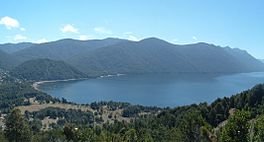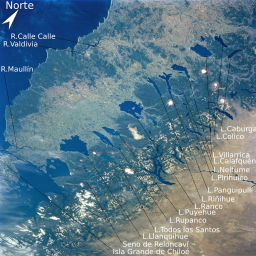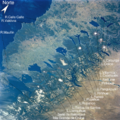Caburgua Lake facts for kids
Quick facts for kids Caburgua Lake |
|
|---|---|
 |
|

Caburga, the northernmost in the map
|
|
| Coordinates | 39°07′40″S 71°46′24″W / 39.12778°S 71.77333°W |
| Type | Fault, glacial and lava dammed |
| Primary inflows | Blanco River |
| Primary outflows | Ojos del Caburgua (an underground outflow) |
| Basin countries | Chile |
| Surface area | 53 km2 (20 sq mi) |
| Settlements | Caburgua |
Caburgua Lake (Spanish pronunciation: [kaˈβuɾɣwa]) is a beautiful lake located about 23 kilometers (14 miles) northeast of Pucón in the La Araucanía Region of Chile. To its east, you'll find the Huerquehue National Park. Like Villarrica Lake, Caburgua Lake is part of the Toltén River basin.
Even if the river flowing out of the lake sometimes dries up in summer, the amazing waterfalls called Ojos del Caburgua never stop flowing. This is because a lot of water from the lake goes underground and feeds the waterfalls.
The lake sits in a valley that was shaped by ancient glaciers (huge sheets of ice). Later, during a time called the Holocene (which started about 11,700 years ago), lava flows from the nearby Volcanes de Caburgua blocked the valley, creating the lake we see today.
Caburgua Lake has become a popular spot for holiday homes. Even former Chilean Presidents like Sebastián Piñera and Michelle Bachelet have vacation houses here.
Contents
A Look Back: History of Caburgua Lake
Who Lived Here First? The Mapuche People
The first people to live around Caburgua before the Spanish arrived were the Pehuenche. They are a group of the Mapuche people. The Pehuenche lived in the southern Andes mountains and often traveled across them. Many of their descendants still live in Caburgua today.
Local people usually call anyone who speaks the native language and has a Mapuche family name simply "Mapuche." The forests where the Mapuche lived were very old and full of life. They stretched from the Pacific coast all the way to the Argentine grasslands.
The Important Pehuén Tree
One of the most important trees for the Mapuche was the Pehuén, also known as the Pino Araucaria. This tree produces many large pine nuts, called piñones. In the fall, when the nuts are ready, locals climb to the Pehuén forests, which are usually high up in the mountains (above 1,000 meters or 3,280 feet). They collect the pine nuts in sacks.
The Mapuche used these nuts in many ways. They would roast them, grind them into flour, boil them, or even make a fermented drink from them. Today, people in the area still eat a lot of these nuts, and you can find them in grocery stores in Pucón during the season.
Farming and Forests
The Mapuche also used natural open areas to grow crops. They planted corn, potatoes, and other vegetables. Sometimes, they would clear land for farming by burning parts of the forest. However, much of the Andes in this region was covered by huge, strong trees like coihue, roble, and raulí. These were very hard to clear.
The Mapuche did burn trees and make canoes from logs. But without metal tools, they couldn't easily cut trees into lumber. When the Spanish arrived and took over these forested areas, they also found it hard to create a lumber industry. This was because they lacked proper machines and ways to transport the wood.
Spanish Arrival and Rebuilding Towns
Even though Caburgua was quite isolated, it has an interesting connection to Chile's history. In the 1500s, when the Spanish first settled in Chile, they quickly founded important cities. These included Santiago in 1541, Concepción in 1550, and Villarrica in 1552.
During its first ten years, Villarrica faced a rebellion from the Mapuche people. The Mapuche destroyed the settlement, but the Spanish rebuilt it. However, in 1603, another Mapuche rebellion forced the Spanish to leave Villarrica and many other communities. These towns disappeared for almost 300 years. Villarrica was only re-established in the 1880s when a railroad was built in Southern Chile. Just three years later, in 1883, the Chilean government built its first fort in Pucón.
Settling the Caburgua Valley
In the early 1900s, people started moving east from Pucón towards Argentina. They were looking for land to settle, log trees, and create farms. Even though some large estates were formed in this region, the Caburgua Valley wasn't ideal for big farms. This was because the soil was poor, made of volcanic sand, and there were many lava deposits.
Because of this, the first people to truly build the Caburgua community were Mapuche inhabitants who had signed land agreements, Chilean farmers (called campesinos), and German immigrants. Interestingly, some Chilean settlers had lived in Argentina for a few years.
The Story of Don Segundo Luengo
One example is Don Segundo Luengo. He was born in southern Chile (Angol) and then went to Argentina. There, he helped his father herd cattle across the southern grasslands. As a young man, he returned to Chile to start his own farm. In 1917, he married Zoila Espinosa and began farming near a place called Cunco.
However, powerful landowners pushed Segundo, Zoila, and other settlers off their land. So, they moved to the more challenging lands of Caburgua. They settled about 1.6 kilometers (1 mile) south of the lake. Together, they cleared the forest, built their simple home, and started their family.
Land Ownership Changes
In the 1970s, during a time when Chile was under a military government, many Mapuche people faced difficulties with their land. Some lost their lands through unfair land grants or sales that were not properly done. Today, former presidents of Chile, like Michelle Bachelet and Sebastián Piñera, own land in this area.
Images for kids
See also
 In Spanish: Lago Caburgua para niños
In Spanish: Lago Caburgua para niños




